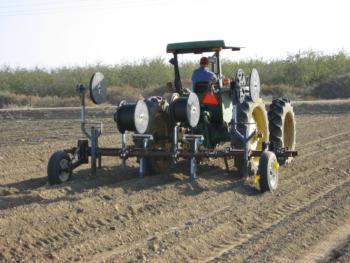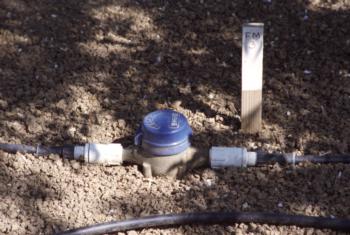Drip tape SDI systems

It is not common to find drip tape lateral ends exposed, but they may be if the laterals are to be flushed by hand. If the drip tape ends are exposed, they are an excellent place to take pressure measurements. Frequently, the drip tape lateral ends will be manifolded together to allow a group of lateral lines to be flushed together. This flushline manifold system is below ground, except for the flushline discharge valve, so the lateral ends are not accessible for pressure measurements.
Pressure measurements
If the SDI drip tape system is entirely below ground, with neither the head nor the tail end of the lateral lines exposed, you may not be able to do an effective self-evaluation of the system. Under those conditions, pressure measurements at those mainline, submain, and flushline locations that are exposed may be the best that you can do.

Using the pressure measurements
The utility of the pressure measurement information you can gather from an SDI system is limited due to there being so few locations at which you can take measurements. If you only gather measurements at the head end or tail end of the tape lateral lines, these pressure readings should be consistent in value. If they are not, there may be too great a loss in pressure along the mainlines and submains. Another possible explanation for significant pressure differences is leaks in the system. Leaks may be evident during a field inspection but some may go undetected.
If you take pressure measurements at the head and tail of the tape lateral lines, the pressure distribution along the mainlines and submains (it should be nearly constant) can be determined, and the pressure losses along the length of drip tape can also be measured. By referring back to the manufacturer's technical information, you can determine whether the pressure loss along the tape lateral is acceptable for maintaining good tape discharge uniformity.
Discharge rate measurements
Direct measurement of SDI drip tape discharge is not practical. It is simply too difficult and time consuming to uncover the drip tape lateral lines and take measurements.
This leaves the use of flow meters as the only means of assessing drip tape discharge rate. While pressure measurements are useful for evaluating the system, it is only by measuring the discharge rate that you can really measure the degree of clogging.
Flow meters
Two flow meter options are available for measuring discharge rates in the drip tape laterals. First, a single flow meter installed at the head of the system can measure the total flow. If pressure is held constant, changes in this flow rate can provide important information. For example, an increase in flow rate may indicate leaks in the system. A decrease in flow rate over time may be indicative of clogging. One disadvantage of using a single flow meter is that if there is an indication of a problem, the single meter does not indicate the location in the system where the problem is occurring.

Keeping records of flow rate and pressure measurements over time, can help in determining whether clogging is occurring in an SDI system. Decreases in flow rates over time, and to a lesser extent, significant increases in pressure may be indicative of clogging problems. If your measurements indicate that there is a clogging problem, click on the link below:
